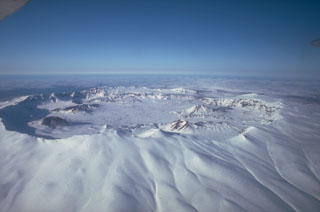Report on Okmok (United States) — 23 July-29 July 2008
Smithsonian Institution / US Geological Survey
Weekly Volcanic Activity Report, 23 July-29 July 2008
Managing Editor: Sally Sennert.
Please cite this report as:
Global Volcanism Program, 2008. Report on Okmok (United States) (Sennert, S, ed.). Weekly Volcanic Activity Report, 23 July-29 July 2008. Smithsonian Institution and US Geological Survey.
Okmok
United States
53.43°N, 168.13°W; summit elev. 1073 m
All times are local (unless otherwise noted)
AVO reported that on 23 July, seismicity from Okmok changed from episodic volcanic tremor to nearly continuous mid-level volcanic tremor. Although cloud cover obscured views of Okmok, previously emitted ash plumes were observed to the ESE. On 24 July, a thermal anomaly was possibly present on satellite imagery. On 25 July, seismic amplitude increased. Based on pilot reports and observations of satellite imagery, AVO reported that ash plumes rose to altitudes of 10.7-12.2 km (35,000-40,000 ft) a.s.l. The Volcano Alert Level was raised to Warning and the Aviation Color Code was raised to Red.
On 26 July, seismic activity decreased and satellite imagery indicated that ash plumes rose to altitudes of 6.1-6.7 km (20,000-22,000 ft) a.s.l. The Volcano Alert Level was lowered to Watch and the Aviation Color Code was lowered to Orange. Seismicity increased again on 27 July. Satellite imagery possibly indicated another thermal anomaly; a possible plume at an altitude of less than 3 km (10,000 ft) a.s.l. was also noted. On 28 July, seismic tremor decreased. An ash plume at a possible altitude of 8.2 km (27,000 ft) a.s.l. drifted 90 km SE. Seismicity changed from nearly continuous volcanic tremor to episodic. Later that day and on 29 July, ash plumes possibly rose to an altitude of 10.7 km (35,000 ft) a.s.l. and drifted E to SE. The Volcano Alert Level was raised to Warning and the Aviation Color Code was raised to Red.
Geological Summary. The basaltic Okmok shield volcano forms the NE end of Umnak Island in the Aleutian Islands. The summit of the low, 35-km-wide volcano is cut by two overlapping 10-km-wide calderas formed during eruptions about 12,000 and 2,050 years ago when dacitic pyroclastic flows reached the coast. More than 60 tephra layers from Okmok have been found overlying the 12,000-year-old caldera-forming tephra layer. Numerous cones and lava domes are present on the flanks down to the coast, including the SE-flank Mount Tulik, which is almost 200 m higher than the caldera rim. Some of the post-caldera cones show evidence of wave-cut lake terraces; more recent cones were formed after the caldera lake, once 150 m deep, disappeared. Eruptions have been reported since 1805 from cinder cones within the caldera, where there are also hot springs and fumaroles.
Source: US Geological Survey Alaska Volcano Observatory (AVO)

